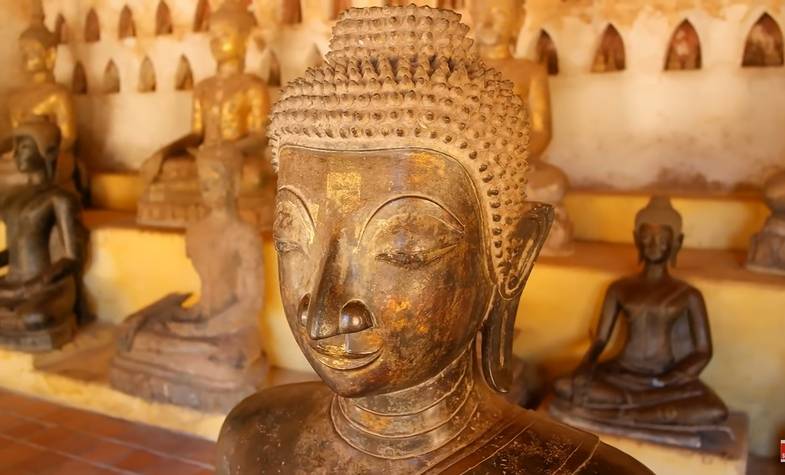Laos has a long-lasting history of traditional art in different fields including sculptures, architecture, paintings, and textiles. This peaceful country proudly owns an exceptional variety within its unique culture, and all the artwork is specified by prominent patterns and impressive decoration. The most ancient form of Laos art is no doubt the architecture and sculptures that appeared at the Buddhist Temples. Many of which still exist now.
Textiles are an important part of Laotian heritage. Historically clothing represents far more than simply protection from the elements. Clothing depicted social standing, religious representation, wealth and family, culture, and ethnicity. Homemade looms of bamboo are used to weave local silk and cotton which were then hand-made into beautifully detailed garments. The art of weaving is still very much alive in Laos and the country is becoming more renowned throughout the world for its intricate patterns and magnificent silks and cotton garments. Another textile form was that of embroidery. Art in the form of paintings seems hard to find, but there is a growing presence in modern day times of artists within Laos.

The woven production and embroidered textiles are absolutely the most creative among all types of Laos ‘s traditional crafts. The traditional weaving techniques are inherited from the old generations. Different local styles may be determined, ranging from the solid color and striped pattern. The design styles which are used also change from region to region.
Ceramic production also has an important role in the long history of the country which is mainly manufactured by companies located in big cities like
Vientiane or
Savannakhet. Among them, some villages still exist and continue to produce utilitarian pottery items for both the domestic and foreign markets.
Gold and silversmithing appeared very early in the modern regions of
Laos and later become a related part of the Khmer empire. After years, mining expanded to supply the raw materials for the production of sophisticated-decorated ceremonial boxes, urns, pieces of jewelry for the royal family, and sacred items for Buddhist temples. Lao Buddha sculpture uses various mediums, including bronze, gold, silver, wood, and precious stones. Among them, bronze is certainly the most widely-used to create many important Buddha statues. Smaller pictures were often made with gold, silver, or precious stones, while wood and ceramics were in high demand of use for creating votive images existed in lots of caves’ system. Woodcarving was considered a branch of sculptural art, and with the expansion of Buddhism, it later becomes more important, especially in producing Buddha images, temples’ carvings, palaces’ gates, roofs, pillars, lintels, etc. Buddhist painting functioned primarily as a means of enhancing religious ritual and took two main forms – bas-relief murals and painted preaching cloths. Depicting Buddha requests the artists to follow strict rules and other important figures.
Lots of crafts have been created and developed over the centuries. Their productions’ purpose is to serve the country’s needs but late it also meets the requirement of other foreign markets.
The production of household items from rattan, bamboo, and other different types of reed has become common for centuries due to the lightness, durability, and termite-résistance.
Paper has been made from sa of mulberry trees’ bark by hand in most parts of the country and this method lasted for about 700 years. Traditionally, people used sa paper to make festive decorations at religious sites, calligraphy, fans, umbrellas, and kites.
Most Laos people as well as numerous ethnic groups living in the country own a rich and impressive heritage of traditional performance which includes lots of genres of great antiquity. After a long time, this heritage has been accompanied by the merging of some contemporary genres, including drama and music.
Two significant performing arts traditions that exist in Laos nowadays are khap call-and-response folk song (also its derivative lam luang) and the elegant classical music and dance (natasinh) established in the royal era.
Communication with the spirits has always figured prominently in Lao daily life, and to this day ritual dances of propitiation continue to be performed in many parts of the country, both by the ethnic Lao and by many minority groups.
Another important typical proto-theatrical activity developed in Laos is the art of sung storytelling with the purpose of teaching morality and perpetuating the various myths, legends, and cosmology associated with particular ethnic groups.
The khene is almost a national symbol to the Laos people - indeed, there is a popular saying to the effect that 'he who lives in a house on stilts, eats sticky rice and plays the khene is a true Lao'.
During the latter half of the 19th century, new popular musical theatre genres were beginning to emerge throughout South East Asia in response to the needs of the growing urban population. The Lao version of the Ramayana epic (Pharak Pharam) is also considered to have been generated during this century to serve as original material for elegant performance.
The traditional Lao folkloric integrate a wide collection of folk dances comprising the welcoming dance fon baci su khuan performed at the event of baci ceremony, the attractive southern female dance fon tang wai, and the interesting male martial arts dance fon dab. The most ancient form of Lao puppetry (as known as lakhon tukkata) may be discovered in
Luang Prabang nowadays.
The earliest literature emerges with lots of legends, myths, proverbs, and cosmology associated with specific ethnic communities. Today, several among them still preserve their tradition very well.

